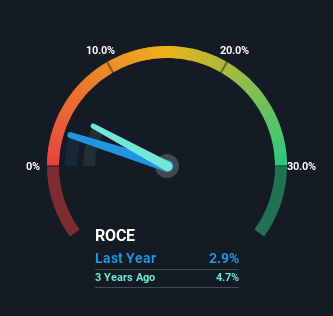Shanxi Yongdong Chemistry Industry (SZSE:002753) Might Be Having Difficulty Using Its Capital Effectively
If you're looking for a multi-bagger, there's a few things to keep an eye out for. Firstly, we'll want to see a proven return on capital employed (ROCE) that is increasing, and secondly, an expanding base of capital employed. If you see this, it typically means it's a company with a great business model and plenty of profitable reinvestment opportunities. In light of that, when we looked at Shanxi Yongdong Chemistry Industry (SZSE:002753) and its ROCE trend, we weren't exactly thrilled.
Return On Capital Employed (ROCE): What Is It?
For those that aren't sure what ROCE is, it measures the amount of pre-tax profits a company can generate from the capital employed in its business. The formula for this calculation on Shanxi Yongdong Chemistry Industry is:
Return on Capital Employed = Earnings Before Interest and Tax (EBIT) ÷ (Total Assets - Current Liabilities)
0.029 = CN¥85m ÷ (CN¥3.3b - CN¥380m) (Based on the trailing twelve months to September 2023).
Therefore, Shanxi Yongdong Chemistry Industry has an ROCE of 2.9%. In absolute terms, that's a low return and it also under-performs the Chemicals industry average of 5.7%.
View our latest analysis for Shanxi Yongdong Chemistry Industry

While the past is not representative of the future, it can be helpful to know how a company has performed historically, which is why we have this chart above. If you want to delve into the historical earnings , check out these free graphs detailing revenue and cash flow performance of Shanxi Yongdong Chemistry Industry.
What Does the ROCE Trend For Shanxi Yongdong Chemistry Industry Tell Us?
In terms of Shanxi Yongdong Chemistry Industry's historical ROCE movements, the trend isn't fantastic. Over the last five years, returns on capital have decreased to 2.9% from 22% five years ago. However it looks like Shanxi Yongdong Chemistry Industry might be reinvesting for long term growth because while capital employed has increased, the company's sales haven't changed much in the last 12 months. It's worth keeping an eye on the company's earnings from here on to see if these investments do end up contributing to the bottom line.
The Key Takeaway
To conclude, we've found that Shanxi Yongdong Chemistry Industry is reinvesting in the business, but returns have been falling. And investors appear hesitant that the trends will pick up because the stock has fallen 43% in the last five years. In any case, the stock doesn't have these traits of a multi-bagger discussed above, so if that's what you're looking for, we think you'd have more luck elsewhere.
Since virtually every company faces some risks, it's worth knowing what they are, and we've spotted 2 warning signs for Shanxi Yongdong Chemistry Industry (of which 1 is a bit unpleasant!) that you should know about.
While Shanxi Yongdong Chemistry Industry may not currently earn the highest returns, we've compiled a list of companies that currently earn more than 25% return on equity. Check out this free list here.
New: Manage All Your Stock Portfolios in One Place
We've created the ultimate portfolio companion for stock investors, and it's free.
• Connect an unlimited number of Portfolios and see your total in one currency
• Be alerted to new Warning Signs or Risks via email or mobile
• Track the Fair Value of your stocks
Have feedback on this article? Concerned about the content? Get in touch with us directly. Alternatively, email editorial-team (at) simplywallst.com.
This article by Simply Wall St is general in nature. We provide commentary based on historical data and analyst forecasts only using an unbiased methodology and our articles are not intended to be financial advice. It does not constitute a recommendation to buy or sell any stock, and does not take account of your objectives, or your financial situation. We aim to bring you long-term focused analysis driven by fundamental data. Note that our analysis may not factor in the latest price-sensitive company announcements or qualitative material. Simply Wall St has no position in any stocks mentioned.
About SZSE:002753
Shanxi Yongdong Chemistry Industry
Engages in the manufacture and sale of chemical raw materials and chemical products in China and internationally.
Good value with adequate balance sheet and pays a dividend.
Market Insights
Community Narratives




